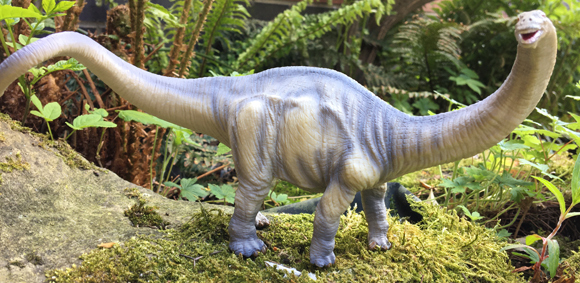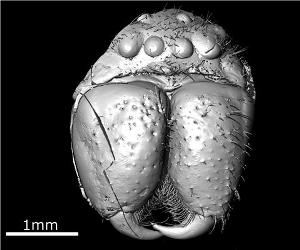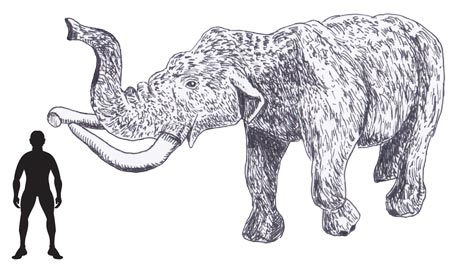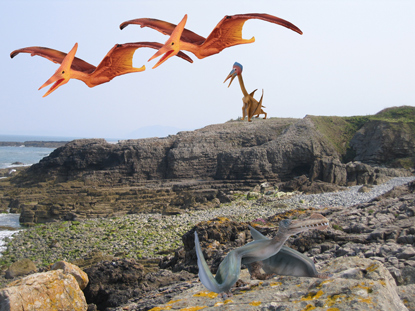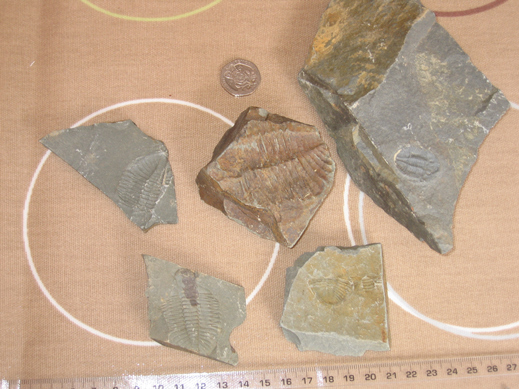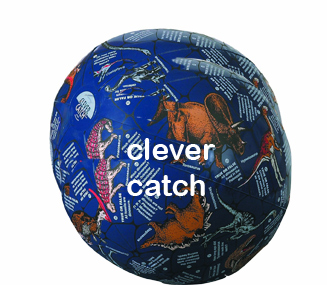New Study Suggest Mammals Liked some Parts, Reptiles Others
One of the conundrums in the science of palaeontology, is why given the uniformity of Pangea during the Triassic was there such a huge increase in the diversity of vertebrate life?. For speciation to occur, (new species to evolve), so the theory of evolution goes, a group of one species of animals needs to become separately from another group of animals from the same species.
For example, if you have a species of leaf-eating lizard living on the coast and in a freak storm a number of individuals are washed out to sea, perhaps floating on broken branches that have become detached from trees during the storm. These lizards, would be able to survive a long period afloat as they need little food or water being cold-blooded. After several weeks, the tides and currents takes this floating raft of storm debris towards a small island many hundreds of miles from the mainland where these lizards used to live.
The branches and the lizards that they contain that have have survived get washed ashore and these little mariners find themselves in a new environment. The habitat may be different, the plant life strange and even the food chains which the lizards are introduced to as interlopers may be different. If this population remains isolated from the mainland leaf-eating population then there is every chance that over time, the lizards will evolve and adapt to their new homes – perhaps becoming over many generations so different from the mainland lizards that they can no longer breed with them and thus, these island lizards would be classified as a separate species. With a different diet of leaves, perhaps due to the limited number of trees on the island, the lizards may well evolve into animals with a more omnivorous diet. Their dentition could change, the size of the jaw muscles, the anatomy of the gut and so on.
More than 200 million years ago, mammals and reptiles lived in their own separate worlds on the super-continent Pangaea, despite little geographical incentive to do so. Mammals lived in areas of twice-yearly seasonal rainfall; reptiles stayed in areas where rains came just once a year. Mammals lose more water when they excrete, and thus need water-rich environments to survive. Results are published in the Proceedings of the National Academy of Sciences.
With the super-continent of Pangea covering much of one hemisphere and being made up of North America, Europe, North Asia, Africa, South America, scientists have puzzled over why the rise and spread of so many vertebrates such as the dinosaurs, when the opportunity for a “gene pool” of a species to become isolated would have been so limited. There were few geographical boundaries to the physical movement of animal populations, no great, continuous mountain chains, no impassable deserts, ice fields and such like. If animals roamed freely across Pangea, gene pools would have remained very readily accessible from animals of that species moving into any area and the opportunities for extensive speciation would have been lost. However, mammals and reptiles did keep to their own areas, each type preferring a particular climate (mammals liking hot and wet, reptiles being more successful in the drier areas.
Triassic Fossils
In a paper published in the scientific journal “The Proceedings of the National Academy of Sciences”, a team of researchers have concluded that more than 200 million years ago, mammals and reptiles lived in their own separate worlds on the super-continent Pangea. Despite little geographical incentive to do so. Mammals lived in areas of twice-yearly seasonal rainfall; reptiles stayed in areas where rains came just once a year. Mammals lose more water when they excrete, compared to reptiles and birds and thus need water-rich environments to survive.
Studying a transect of Pangea stretching from about three degrees south to 26 degrees north (a long swath in the centre of the continent covering tropical and semi-arid, temperate zones), a team of scientists led by Jessica Whiteside at Brown University (Rhode Island, USA) has determined that reptiles, represented by a group called procolophonids, lived in one area, while mammals, represented by a precursor species called traversodont cynodonts, lived in another. Though similar in many ways, their paths evidently did not cross.
Assistant Professor Whiteside commented:
“We’re answering a question that goes back to Darwin’s time. What controls where organisms live? The two main constraints are geography and climate.”
Turning to climate, the frequency of rainfall along lines of latitude directly influenced where animals lived, the scientists conclude. In the tropical zone where the mammal-relative traversodont cynodonts lived, monsoon-like rains fell twice a year. But farther north on Pangea, in the temperate regions where the procolophonids predominated, major rains occurred only once a year. It was the difference in the precipitation, the researchers conclude, that sorted the mammals’ range from that of the reptiles.
On Pangea, the mammals needed a water-rich area, so the availability of water played a decisive role in determining where they lived.
Assistant Professor Whiteside added:
“It’s interesting that something as basic as how the body deals with waste can restrict the movement of an entire group.”
In water-limited areas, “the reptiles had a competitive advantage over mammals,” Whiteside commented. She thinks the reptiles didn’t migrate into the equatorial regions because they already had found their niche.
The researchers compiled a climate record for Pangea during the Late Triassic period, from 234 million years ago to 209 million years ago, using samples collected from lakes and ancient rift basins stretching from modern-day Georgia to Nova Scotia. Pangea was a hothouse then; temperatures were about 20 degrees Celsius hotter in the summer, and atmospheric carbon dioxide was five to 20 times greater than today. Yet there were regional differences, including rainfall amounts.
Glossopteris Plant Fossils – Provide an Insight to Pangea
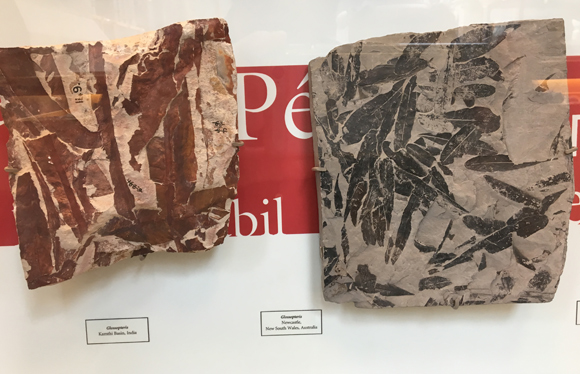
Examples of Glossopteris fossils from different parts of the world – India (left) and Australia (right). Picture credit: Everything Dinosaur.
Picture credit: Everything Dinosaur
The researchers base the rainfall gap on variations in Earth’s precession, or the wobble on its axis, coupled with the eccentricity cycle, based on Earth’s orbital position to the sun. Together, these Milankovitch cycles influence how much sunlight, or energy, reaches different areas of the planet. During the Late Triassic, the equatorial regions received more sunlight, thus more energy to generate more frequent rainfall. The higher latitudes, with less total sunlight, experienced less rain.
The research is important because climate change projections for our own time on planet Earth, show areas that would receive less precipitation, which could put mammals there under stress.
Typical Terrestrial Life During the Late Triassic
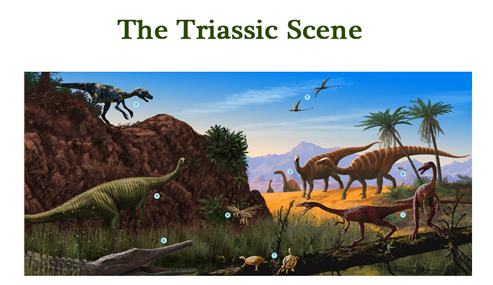
Triassic scene from the dinosaur timeline poster. Typical terrestrial life during the Late Triassic.
Relating the Pangea evidence to today’s problem with climate change, research graduate Danielle Grogan, part of Associate Professor’s Whiteside research Group stated:
“There is evidence that climate change over the last 100 years has already changed the distribution of mammal species. Our study can help us predict negative climate effects on mammals in the future.”
For models and replicas of Triassic prehistoric animals including early dinosaurs: CollectA Deluxe Prehistoric Animal Scale Models.


